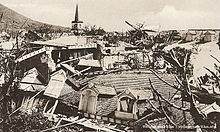 Damage in Port Louis from the storm | |
| Meteorological history | |
|---|---|
| Formed | April 1892 |
| Dissipated | After 29 April 1892 |
| Category 3-equivalent tropical cyclone | |
| 1-minute sustained (SSHWS) | |
| Highest winds | 195 km/h (120 mph) |
| Highest gusts | 215 km/h (135 mph) |
| Lowest pressure | 947 hPa (mbar); 27.96 inHg |
| Overall effects | |
| Fatalities | 1,200 total (Fourth-deadliest tropical cyclone recorded in the Southern Hemisphere) |
| Damage | $9.75 million (1892 USD) |
| Areas affected | Mauritius |
Part of the List of South-West Indian Ocean cyclones before 1960 | |
On 29 April 1892, a powerful tropical cyclone struck the island of Mauritius in the southwest Indian Ocean. At least 1,200 people died during the storm, and another 4,000 were injured, with 50,000 people left homeless, making the cyclone the third-deadliest tropical cyclone recorded in the South-West Indian Ocean basin, behind Cyclone Freddy in 2023 and Cyclone Idai in 2019. It is also the fourth-deadliest recorded in the Southern Hemisphere, behind the aforementioned Cyclones Freddy and Idai, and the 1973 Flores cyclone.[1] The storm originated north of the island, and local meteorologists expected that the storm would remain away from the island. Consequentially, residents were unprepared until the arrival of the strong winds. For a span of 65 minutes, the calm of the storm's eye occurred on the island, before the winds again increased, reaching 195 km/h (121 mph), with gusts to 216 km/h (134 mph). During the storm, the barometric pressure dropped to 947 mbar (27.96 inHg), breaking the 74-year-old record for the lowest recorded pressure on the island.
The damage on Mauritius was so severe that contemporaneous newspapers questioned whether the island would recover. Damage was estimated at £2,000,000 (1892 GBP, $9.75 million USD).
- ^ Masters, Jeff. "Africa's Hurricane Katrina: Tropical Cyclone Idai Causes an Extreme Catastrophe". Weather Underground. Retrieved 23 March 2019.